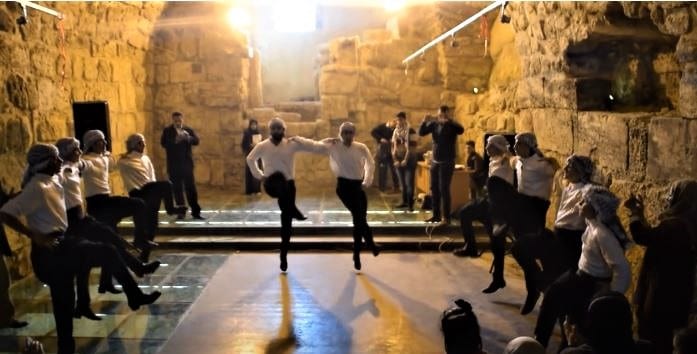
Discovering Dabka with Yahya and the Sebastia Archeologica team
We are in the courtyard of Sebastia’s Mosaic Guest House. A dance show has just finished and with us there is Yahya, a young man of 24, who at a certain point tells how his adventure with the dabka, the famous Palestinian folk dance, began. Together with two other friends, Yahya is the founder of Sebastia’s first group of Dabka dancers. They are called Firqet Athar Sebastia (Sebastia Archeologica Dabka team) and perform in weddings and shows for tourists with this eventful dance that requires a good physical performance.
The onomatopoeic name recalls the sound of stamping feet: the dancers holding hands, jumping and stamping their feet letting themselves be guided by the pressing rhythm of the music. The dance, which originates from the rural world, is widespread throughout the Middle East, but for the Palestinians it has a unique value: it is an expression of the joy of being together. The choice of the name is not accidental and emphasizes attention to one’s roots. “Sebastia is known throughout Palestine for the Roman colonnade and the archaeological site – Yahya tells us – with dance and with this name we show the attachment to our land and bring Sebastia’s fame with us”. The idea was born in front of a cafe in front of the basilica and the Roman forum, when “we realized that there was no group able to do dabka shows for the many tourists who visit our ruins. So we started watching videos on YouTube of professional dancers and training to be able to reproduce those steps “.
To those first three boys, over time, other young people have joined and today the group is composed of 14 elements that are trained every Thursday by Yahya and are committed to creating increasingly complex and professional dabka shows. Sebastia’s people at first were a bit dubious, but then he began to appreciate the group that is now being called to almost all the marriages in the country. “Thanks to the offers – says Anjad – we were able slowly to buy the costumes for the exhibitions and some musical instruments like the Darabouka, the Arab drum, which is played to give rhythm to the dance”.
From all of them there emerges a great passion and the desire to improve. The next goal they want to achieve is the purchase of new traditional costumes with fine handmade embroidery for all dancers. “This is a considerable amount, but we hope to succeed thanks to the proceeds from the upcoming exhibitions,” adds Yahya.
Proud of the success of the Sebastia Archeologica Team, Shadi, manager of Sebastia’s guest house, has decided to organize a dabka show with them for groups of tourists staying in the Guest House created by the Association pro Terra Sancta and Mosaic Center. The guests, after attending the exhibition, are invited to join the dances in a short trial lesson. “There are not many places where tourists can learn this dance. Coming to Sebastia, they can visit the archaeological site, eat traditional foods and learn about our culture, “says Shadi proudly.
The boys show us on their phones some videos of the evenings already held in the premises in Nusf Jubeil’s kitchen: “Look, it’s easy!” of music. Because listening to the dabka you can’t just watch, you have to dance!